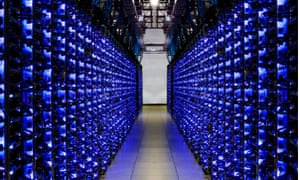In a time period when global warming and climate change are on everyone’s mind and a rather important topic of discussion, Google is stepping up to do their part. It’s no surprise that by using machine learning, they are helping the environment. This basically means that they are using artificial intelligence (AI) to cut their energy usage as opposed to humans doing the same job.
The amount of energy that is saved in their massive data centers across the globe is 15% so far. By using DeepMind technology, an AI company that Google purchased in 2014, they are able to anticipate incoming higher-than-normal data loads and then cool the system before it gets past the point of needing a big surge of energy to do that.
How many jobs were lost? That isn’t mentioned in the following article from The Guardian, but it is fascinating how Google is using machine learning to lower energy usage. It sounds pretty futuristic, but Google never fails to amaze me with their integration of AI technology.
Google uses AI to cut data centre energy use by 15% | Environment | The Guardian
 Google says it has cut its vast data centres’ energy use by 15% by applying artificial intelligence to manage them more efficiently than humans.
Google says it has cut its vast data centres’ energy use by 15% by applying artificial intelligence to manage them more efficiently than humans.
The servers that power billions of web searches, streamed films and social media accounts are estimated to account for approximately 2% of global greenhouse gas emissions. Google is believed to have one of the biggest fleets of them in the world.
On Wednesday, Google said it had proved it could cut total energy use at its data centres by 15% by deploying machine learning from DeepMind, the British AI company it bought in 2014 for about £400m. Such centres require significant energy for cooling, as well as constant adjustments to air temperature, pressure and humidity, to run as efficiently as possible.
Mustafa Suleyman, DeepMind’s co-founder, said that the level of complexity and number of variables meant the job of managing data centres was one where an algorithm could outperform a human.
He said: “It’s one of those perfect examples of a setting where humans have a really good intuition they’ve developed over time but the machine-learning algorithm has so much more data that describes real-world conditions [five years in this case].
“It’s much more than any human has ever been able to experience, and it’s able to learn from all sorts of niche little edge cases seen in the data that a human wouldn’t be able to identify. So it’s able to tune the settings much more subtly and much more accurately.”
Suleyman said the reduction in energy use was achieved through a combination of DeepMind more accurately predicting the incoming computational load – ie when people were mostly likely to request data-hungry YouTube videos – and match that prediction very quickly to the cooling load required. “It’s about tweaking all of the knobs simultaneously,” he said.
The environmental impact of the online world has come under increasing scrutiny in recent years, as data centres’ share of global emissions has risen to be on a par with those from aviation. Google first disclosed its carbon footprint in 2011 – it was roughly equivalent to Laos’s annual emissions – and says that since then its data centres have improved so that they get 3.5 times the computing power for the same amount of energy.
The trial using machine learning to further cut those data centres’ energy – and carbon emissions – began two years ago, and was tested on “more than 1%” of its servers, Suleyman said. It is now being used across a “double-digit percentage” of all Google’s data centres globally and will be applied across all of them by the end of the year.
Google does not disclose exactly how much energy its data centres use, but says as a company it’s responsible for 0.01% of global electricity use, and much of that is data centres. DeepMind has cut Google’s energy use for cooling by 40%, and total energy use by 15%.
“I really think this is just the beginning. There are lots more opportunities to find efficiencies in data centre infrastructure,” said Suleyman. “One of the most exciting things is the kind of algorithms we develop are inherently general … that means the same machine-learning system should be able to perform well in a wide variety of environments [such as power generation facilities and energy networks].”
Google is also using renewable energy to save money. This interview with Google’s Head of Energy Strategy explains that the deals made with renewable energy companies are long term and will help save a significant amount of money. She noted that the cost of solar has come down 80% in the last six years and the price of wind energy has come down 60% in the same amount of time:
In this Tweet, which is linked to another similar article by Bloomberg, the process that DeepMind uses is compared to that of playing a video game, where the end goal is to achieve the “highest score” of saving energy. It also mentions that although Google is helping the environment, they are also helping their own bottom line with big savings in electricity costs at their data centers.


No comments:
Post a Comment